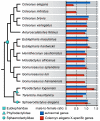Independent Evolution of Sex Chromosomes in Eublepharid Geckos, A Lineage with Environmental and Genotypic Sex Determination
- PMID: 33322017
- PMCID: PMC7763811
- DOI: 10.3390/life10120342
Independent Evolution of Sex Chromosomes in Eublepharid Geckos, A Lineage with Environmental and Genotypic Sex Determination
Abstract
Geckos demonstrate a remarkable variability in sex determination systems, but our limited knowledge prohibits accurate conclusions on the evolution of sex determination in this group. Eyelid geckos (Eublepharidae) are of particular interest, as they encompass species with both environmental and genotypic sex determination. We identified for the first time the X-specific gene content in the Yucatán banded gecko, Coleonyx elegans, possessing X1X1X2X2/X1X2Y multiple sex chromosomes by comparative genome coverage analysis between sexes. The X-specific gene content of Coleonyx elegans was revealed to be partially homologous to genomic regions linked to the chicken autosomes 1, 6 and 11. A qPCR-based test was applied to validate a subset of X-specific genes by comparing the difference in gene copy numbers between sexes, and to explore the homology of sex chromosomes across eleven eublepharid, two phyllodactylid and one sphaerodactylid species. Homologous sex chromosomes are shared between Coleonyx elegans and Coleonyx mitratus, two species diverged approximately 34 million years ago, but not with other tested species. As far as we know, the X-specific gene content of Coleonyx elegans / Coleonyx mitratus was never involved in the sex chromosomes of other gecko lineages, indicating that the sex chromosomes in this clade of eublepharid geckos evolved independently.
Keywords: DNA-seq; Gekkota; qPCR; reptiles; sex chromosomes; sex determination.
Conflict of interest statement
The authors declare no conflict of interest.
Figures


Similar articles
-
Madagascar Leaf-Tail Geckos (Uroplatus spp.) Share Independently Evolved Differentiated ZZ/ZW Sex Chromosomes.Cells. 2023 Jan 9;12(2):260. doi: 10.3390/cells12020260. Cells. 2023. PMID: 36672195 Free PMC article.
-
Identification of a cis-sex chromosome transition in banded geckos (Coleonyx, Eublepharidae, Gekkota).J Evol Biol. 2022 Dec;35(12):1675-1682. doi: 10.1111/jeb.14022. Epub 2022 Jun 5. J Evol Biol. 2022. PMID: 35665979 Review.
-
Differentiation of sex chromosomes and karyotypic evolution in the eye-lid geckos (Squamata: Gekkota: Eublepharidae), a group with different modes of sex determination.Chromosome Res. 2010 Nov;18(7):809-20. doi: 10.1007/s10577-010-9154-7. Epub 2010 Sep 2. Chromosome Res. 2010. PMID: 20811940
-
Microsatellite distribution on sex chromosomes at different stages of heteromorphism and heterochromatinization in two lizard species (Squamata: Eublepharidae: Coleonyx elegans and lacertidae: Eremias velox).BMC Genet. 2011 Oct 20;12:90. doi: 10.1186/1471-2156-12-90. BMC Genet. 2011. PMID: 22013909 Free PMC article.
-
A review of sex determining mechanisms in geckos (Gekkota: Squamata).Sex Dev. 2010;4(1-2):88-103. doi: 10.1159/000289578. Epub 2010 Mar 16. Sex Dev. 2010. PMID: 20234154 Free PMC article. Review.
Cited by
-
Heteromorphic ZZ/ZW sex chromosomes sharing gene content with mammalian XX/XY are conserved in Madagascan chameleons of the genus Furcifer.Sci Rep. 2024 Feb 28;14(1):4898. doi: 10.1038/s41598-024-55431-9. Sci Rep. 2024. PMID: 38418601 Free PMC article.
-
Diversity of reptile sex chromosome evolution revealed by cytogenetic and linked-read sequencing.Zool Res. 2022 Sep 18;43(5):719-733. doi: 10.24272/j.issn.2095-8137.2022.127. Zool Res. 2022. PMID: 35927394 Free PMC article.
-
Poorly differentiated XX/XY sex chromosomes are widely shared across skink radiation.Proc Biol Sci. 2021 Jan 27;288(1943):20202139. doi: 10.1098/rspb.2020.2139. Epub 2021 Jan 20. Proc Biol Sci. 2021. PMID: 33468012 Free PMC article.
-
Madagascar Leaf-Tail Geckos (Uroplatus spp.) Share Independently Evolved Differentiated ZZ/ZW Sex Chromosomes.Cells. 2023 Jan 9;12(2):260. doi: 10.3390/cells12020260. Cells. 2023. PMID: 36672195 Free PMC article.
-
Sex chromosome evolution among amniotes: is the origin of sex chromosomes non-random?Philos Trans R Soc Lond B Biol Sci. 2021 Sep 13;376(1833):20200108. doi: 10.1098/rstb.2020.0108. Epub 2021 Jul 26. Philos Trans R Soc Lond B Biol Sci. 2021. PMID: 34304592 Free PMC article.
References
-
- Capel B. Sex Determination in Vertebrates. 1st ed. Elsevier Science; London, UK: 2019. pp. 1–395.
-
- Pokorná M., Kratochvíl L. Phylogeny of sex-determining mechanisms in squamate reptiles: Are sex chromosomes an evolutionary trap? Zool. J. Linn. Soc. 2009;156:168–183. doi: 10.1111/j.1096-3642.2008.00481.x. - DOI
Grants and funding
LinkOut - more resources
Full Text Sources
Research Materials

